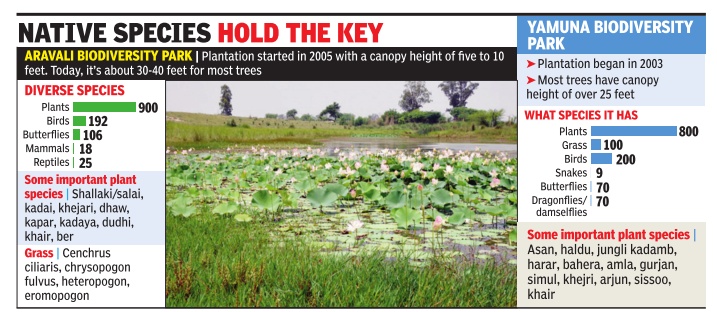Delhi: Flora, forests

This is a collection of articles archived for the excellence of their content. |

Decline in green cover: 1986-2015
The Times of India, Aug 30 2015
Overall decline in green cover since 1986: Study A recent study on the city's green cover shows a disturbing trend. Delhi's vegetation has seen an overall decline since 1986.The green cover is also increasingly becoming fragmented, the study reveals.The highest fragmentation is being seen on the periphery where afforestation work is being conducted to compensate for the loss of trees to urban development projects. However, it is also only on the periphery that the green cover is increasing while the same is on the wane in the core and transitional areas. The study by Ashoka Trust for Research in Ecology and Environment (ATREE), Manipal Academy of Higher Education and Azim Premji University , highlights that though vegetation is increasing on the periphery, rapid urbanization and expanding real estate business could put this in danger. “Farm lands, wetlands, open spaces and trees on the periphery have been rapidly converted into urban built-up areas. With this, the vegetated landscape of Delhi is becoming increasingly fragmented like Shenzen, Daqing and Mumbai“ the study states.
For instance, the green cover in Delhi's core area in 1986 was about 64.68%, but it reduced to about 43.98% in 2010. Vegetation in the transitional area was 25.32% which marginally reduced to 22.43% but the peripheral green cover increased from 13.22% in 1986 to 16.52% in 2010.
“My study shows that there is an overall decline in the green cover in the past 25 years and the vegetated landscape is increasingly becoming fragmented. But when we look at different zones, we find that the core has maximum vegetation but it is also declining since 1986. The transitional zone has lesser proportion of vegetation than the core area. Though there has been a slight increase in the green cover in this zone from 1986 to 1999, the period between 2000 and 2010 saw a steady decline,“ said Somajita Paul, co-author of the study , which was conducted using satellite images for all these years.
The Ridge
20% of Ridge lost after 1996
The Times of India, June 5, 2016

Jayashree Nandi
In spite of being one of the most polluted cities in the world, Delhi's only lung capable of absorbing a part of the emissions remains unprotected. Bit by bit, the urban sprawl is gnawing away at the already disjointed parts of the Delhi Ridge. According to the Delhi forest department's recent estimates, up to 20% of the Ridge may have been lost in the past two decades since the Supreme Court directed that the green belt be protected in its “pristine glory“.
The Ridge Management Board (RMB), headed by Delhi's chief secretary, will meet on Monday to discuss the much-needed demarcation of the Ridge.Environmentalists who have been campaigning to save the Ridge claim that successive governments have avoided the issue of demarcating the Ridge because such an exercise involves “tough“ and “unpopular“ decisions like evicting encroachers. The forest department says encroachments existed even before Supreme Court's order in 1996, but they have expanded over the years.
Legally , the Ridge is not a reserve forest. A 1994 notification had intended to declare all forest areas in Delhi, including the Ridge, as reserve forests. However, the demarcation and the settling of land rights leading to a final legal seal of protection was never completed. In 2013, the National Green Tribunal (NGT) gave the forest department six months to issue a final notification after demarcating the Ridge area and settling the rights of people living there. But when the department started demolishing encroachments in Asola in the southern Ridge, the largest Ridge stretch in Delhi, some residents moved the NGT claiming rightful ownership of the land.
Geospatial maps commissioned by the forest department did not tally with the records of the revenue department, and so the chief secretary handed over the demarcation to the revenue department, which is still working on it. Some of the geo-spatial maps now appear on the forest department's website.
Sources in the forest department told TOI that the existing encroachments are expanding even as the revenue department strives to map the area. Not all Ridge residents are poor squatters. Many are rich and powerful and have homes within the Ridge area as recognised by the forest department. An incumbent RMB member said, “It's appalling that people are up in arms when a single tree is cut in the city but aren't bothered about the loss of a large forest.“